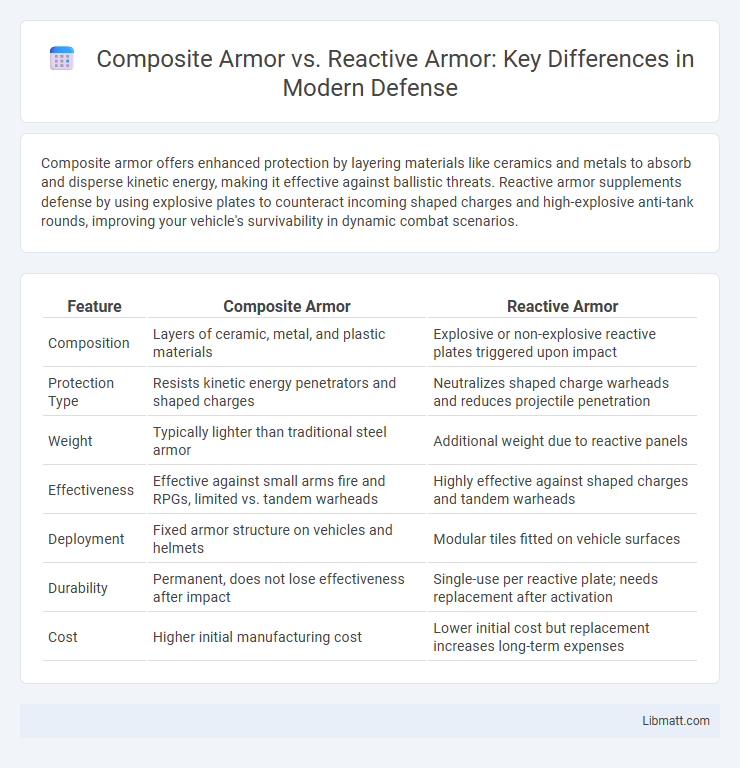Composite armor offers enhanced protection by layering materials like ceramics and metals to absorb and disperse kinetic energy, making it effective against ballistic threats. Reactive armor supplements defense by using explosive plates to counteract incoming shaped charges and high-explosive anti-tank rounds, improving your vehicle's survivability in dynamic combat scenarios.
Table of Comparison
| Feature | Composite Armor | Reactive Armor |
|---|---|---|
| Composition | Layers of ceramic, metal, and plastic materials | Explosive or non-explosive reactive plates triggered upon impact |
| Protection Type | Resists kinetic energy penetrators and shaped charges | Neutralizes shaped charge warheads and reduces projectile penetration |
| Weight | Typically lighter than traditional steel armor | Additional weight due to reactive panels |
| Effectiveness | Effective against small arms fire and RPGs, limited vs. tandem warheads | Highly effective against shaped charges and tandem warheads |
| Deployment | Fixed armor structure on vehicles and helmets | Modular tiles fitted on vehicle surfaces |
| Durability | Permanent, does not lose effectiveness after impact | Single-use per reactive plate; needs replacement after activation |
| Cost | Higher initial manufacturing cost | Lower initial cost but replacement increases long-term expenses |
Introduction to Composite and Reactive Armor
Composite armor combines multiple layers of materials such as ceramics, metals, and plastics to absorb and dissipate the energy from projectiles and explosive impacts. Reactive armor consists of explosive-filled plates that detonate upon contact, disrupting the penetration of shaped charges and kinetic energy penetrators. Your choice between composite and reactive armor depends on the specific threat environment and the balance between protection, weight, and mobility requirements.
Defining Composite Armor: Materials and Structure
Composite armor consists of layered materials such as ceramics, metals, and plastics designed to absorb and dissipate kinetic energy from projectiles and shaped charges. Its structure typically includes hard ceramic plates bonded to a metal backing, which disrupts the penetration mechanism of incoming threats. This multi-material composition enhances protection by combining hardness and toughness to reduce armor penetration more effectively than traditional steel armor.
Reactive Armor: Types and Functionality
Reactive armor consists mainly of Explosive Reactive Armor (ERA) and Non-Explosive Reactive Armor (NERA), designed to counteract the impact of anti-tank projectiles and shaped charges. ERA uses explosive layers sandwiched between metal plates that detonate upon impact, disrupting the penetrator's energy, while NERA employs elastic materials to absorb and deflect warhead energy without explosions. Your choice between these types depends on operational safety, vehicle weight constraints, and threat profiles encountered on the battlefield.
Historical Development of Composite and Reactive Armor
Composite armor was first developed during the Cold War to provide enhanced protection by layering different materials like ceramics and metals, effectively countering kinetic energy penetrators. Reactive armor emerged later in the 1980s, designed to explode outward upon impact, disrupting the energy of shaped charge warheads before they could penetrate. Understanding these historical developments helps you appreciate the evolution of armored vehicle defense against increasingly sophisticated threats.
Comparative Effectiveness Against Kinetic Energy Projectiles
Composite armor offers superior protection against kinetic energy projectiles by combining layers of ceramics, metals, and polymers to absorb and dissipate energy effectively. Reactive armor complements this by deterring shaped charge warheads through explosive countermeasures, although its effectiveness against kinetic energy rounds is limited. For your vehicle's defense, integrating composite armor enhances resistance to high-velocity penetrators, while reactive armor can provide additional, albeit minimal, defense against kinetic threats.
Performance Against Shaped-Charge Warheads
Composite armor provides enhanced protection against shaped-charge warheads by using multiple layers of different materials such as ceramics, metals, and plastics, which disrupt and absorb the explosive jet more effectively than traditional steel armor. Reactive armor, on the other hand, uses explosive or non-explosive reactive plates that detonate outward upon impact, neutralizing the shaped charge jet before it penetrates the vehicle's main armor. Your choice between composite and reactive armor should consider factors like the threat environment, as composite armor offers consistent passive defense, while reactive armor is highly effective against specific shaped-charge attacks.
Weight and Mobility Considerations
Composite armor offers a balance between protection and weight, enhancing vehicle mobility by using layered materials such as ceramics, metals, and plastics to absorb and dissipate energy without excessive bulk. Reactive armor adds explosive tiles that detonate upon impact to counter shaped charges but increases overall weight, potentially reducing maneuverability and speed. Weight considerations in reactive armor systems can affect vehicle acceleration and fuel efficiency, whereas composite armor's lighter structure supports greater operational flexibility in diverse terrains.
Maintenance and Field Longevity
Composite armor requires less frequent maintenance due to its solid, multi-layered structure that resists wear and environmental damage. Reactive armor demands rigorous upkeep as its explosive elements degrade over time and after impacts, reducing effectiveness. Field longevity favors composite armor for sustained missions, while reactive armor is optimal for short-term, high-risk engagements requiring quick replacement.
Applications in Modern Military Vehicles
Composite armor provides enhanced protection against kinetic energy penetrators and shaped charges through layered materials like ceramics and metals, making it ideal for main battle tanks and armored personnel carriers. Reactive armor, featuring explosive or non-explosive reactive elements, counters anti-tank missiles and RPGs by disrupting the incoming warhead's effectiveness, commonly applied on tanks and infantry fighting vehicles in high-threat combat zones. Your choice of armor depends on operational needs, balancing protection, weight, and vehicle mobility in modern military applications.
Future Trends in Armor Technology
Future trends in armor technology emphasize enhancing composite armor with advanced nanomaterials and smart sensors to improve damage detection and resistance against kinetic and shaped-charge threats. Reactive armor development is shifting towards modular and electrically-controlled systems capable of countering evolving tandem warheads and drone attacks more effectively. Integration of artificial intelligence and adaptive materials is anticipated to revolutionize the protective capabilities of both composite and reactive armor in next-generation military vehicles and personal protection gear.
composite armor vs reactive armor Infographic

 libmatt.com
libmatt.com